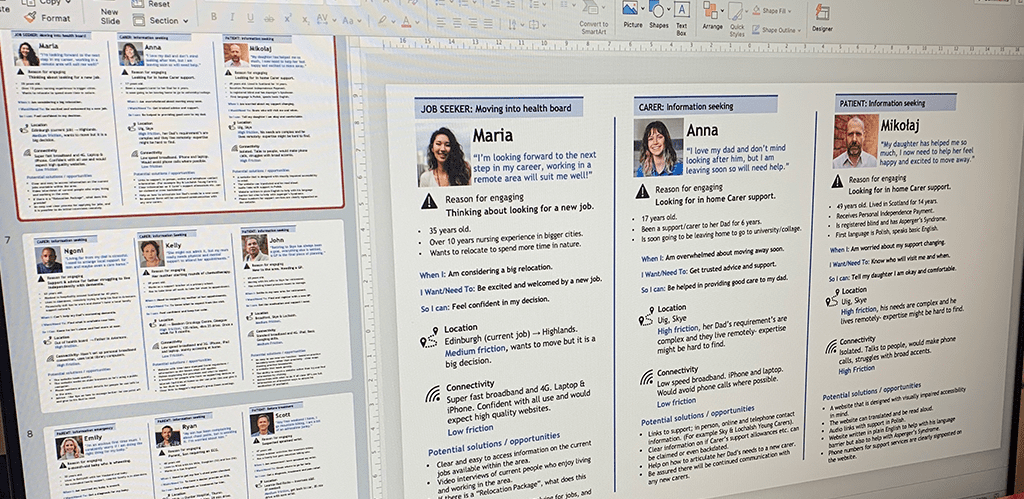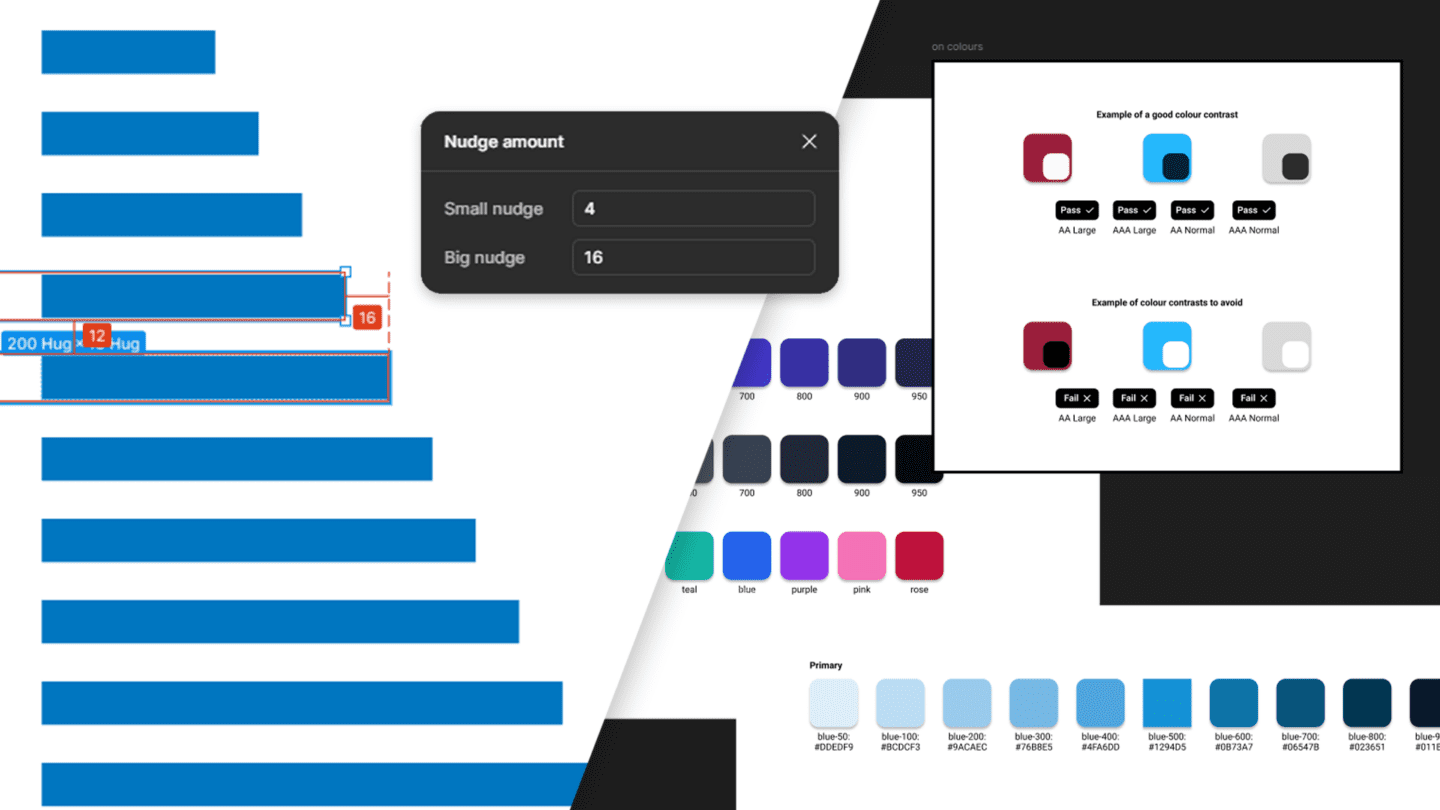
The NHS Highland website had existed in its previous form for over a decade. It had long been viewed by the organisation as offering an outdated experience for service users, staff, and stakeholders; with knock-on effects for services and how NHS Highland was perceived.
In 2022, Factory 73 was commissioned to develop a new website for NHS Highland. As long-term partners, Border Crossing UX were engaged to help ensure a user centred approach was maintained throughout the process.
Aligning to NHS Digital and Scottish Approach to Service Design Principles
Both the NHS Design principles and the Scottish Approach to Service Design (SAtSD) urge those developing new digital services to share the knowledge and resources they acquire on projects with other NHS teams’. Which is why, with the full support of our partners and clients, we’ve used this post to share:
- What we were tasked with doing.
- The purpose, and target audience, for the proto-personas developed.
- Our approach to developing the required proto-personas.
- Key tips when developing proto-personas.
- Templates and downloads you can use to inform your proto-persona development process.
What we did
In this post we’ll share our approach to achieving two of the five key objectives we were engaged to fulfil on this project:
- Translating ‘discovery’ research with the public, staff and stakeholders into phased development requirements.
- Developing user needs articulated in ‘discovery’ research into target proto-personas that guide the user experience.
This involved analysing and extracting key information and insights from:
- ‘Discovery’ research aggregated prior to the outset of the project. This provided the core information required to identify user needs and high-level functional requirements.
- Stakeholder research conducted throughout the project in collaboration with NHS Highland. This enabled us to identify and/or validate key scenarios, triggers, and variables that were likely to influence if and how citizens and staff were likely to interact with NHS Highland across channels.
- Secondary research on geography, travel options, connectivity, and local residents’ lived experience. This ensured we were able to translate best practice guidance into specific and localised requirements.
Understanding the purpose of the proto-personas
At the outset of the project Border Crossing UX collaborated with Factory 73 and NHS Highland to identify the purpose of the proto-personas to be developed. This highlighted that there were two distinct target audiences and desired outcomes for this key deliverable:
1. Internal senior leadership teams
Who needed to sign-off on the pivot from a board-centric to citizen-focussed approach to information architecture.
2. The project team
Who needed to validate ‘discovery research’, the phasing of requirements, and have a deeper understanding of more granular user needs.
Analysing the information available
Identifying this at the outset of the process ensured we were able to do the research required to develop a set of proto-personas that informed a key strategic decision, whilst also providing a robust overview of how to phase functional requirements.
Border Crossing UX collaborated with NHS Highland to analyse the primary research and key recommendations detailed within a Website Review report developed by Graft. This provided a valuable overview of the distinctive characteristics of the NHS Highland area; including geography, demographics, digital connectivity and digital exclusion, and their implications for the future website.
“It is really important to us at NHS Highland to put people using our services first, and to design services around their needs to give them the best experience. The website is a key place to demonstrate this and using proto personas really brought that to life. We’ve had lots of positive comments about how straightforward and easy to use the new site is.”
Ruth Fry – Head of Communications and Engagement, NHS Highland
It also provided an excellent breakdown of the following:
Key user types:
- Citizens.
- Patients.
- Enablers.
- NHS Highland professionals and stakeholders.
- Deliverers services to NHS Highland.
- NHS-led.
- Partner-led.
- Manages people at NHS Highland.
- Works at NHS Highland.
- Ensures good governance and policy compliance.
- Communicates with NHS Highland (e.g. press, politicians, other key stakeholders).
- Deliverers services to NHS Highland.
- Universal needs.
- Visually impaired.
- Hearing impaired.
- Senior citizens.
- Non-English speakers.
Key information:
- Attitudes towards health services online and the NHS Highland website.
- Reasons for using health service information online.
- Reason for using Health Board sites.
- Reasons for using sources other than Health Board sites.
- Reasons for visiting the NHS Highland website.
- Barriers to visiting the NHS Highland website.
- Users’ ideal NHS Highland website.
- User journey of a patient (Keeping up to date, Seeking information, Seeking treatment, In-treatment, After the treatment)
This up-front input provided excellent guidance in terms of the:
- Range of scenarios and use cases that had to be accommodated.
- Universal needs that had to be met.
- Digital exclusion barriers that had to be acknowledged and responded to.
Getting into the detail
This information was supplemented by further research into digital connectivity and mobile coverage across the NHS Highland area. In addition to this, we collaborated with NHS Highland to build a deeper understanding of delivering health and care services across some of the most remote and sparsely populated parts of the United Kingdom. This involved investigating and identifying the following:
Triggers that would prompt the people to engage with NHS Highland:
- Thinking about looking for a new job in the Highlands.
- Looking for in home Carer support for her dad.
- Looking for in home Carer support for himself.
- Looking for support and advice for parent struggling to live independently with dementia.
- Mother starting rounds of chemotherapy seeking information on what to expect.
- New to the area and needing to register with a GP.
- Parent of a 6-month-old baby with breathing difficulties trying to identify where to go/what to do next.
- Parent seeking to arrange an ECG appointment on behalf of their teenage son.
- Find out where to go given a suspected sprained wrist.
- Seeking sexual health information and finding out how to get tested.
- Know what to expect in advance of a joint replacement and overnight stay.
- Preparing for a dialysis appointment.
- Referred for an MRI and wanting to learn where this is likely to be/what to expect/what they need to do.
- Seeking information on how to get support for a long term condition.
- Wants to provide feedback following a positive in-patient experience.
Locations:
These encompassed the breadth of urban centres, towns, villages, and remote settlements across one the most sparsely populated and remote parts of the United Kingdom:
- Uig, Skye.
- Mull.
- Broadford, Skye & Lochalsh.
- Bettyhill.
- Wick.
- Learnie Red Rocks.
- Dingwall.
- Nairn.
- Mallaig.
- Campbeltown.
- Oban.
- Spean Bridge.
This was an iterative process. As the specific healthcare journey a person was likely to experience was heavily dependent on both location and trigger, for example:
“Kevin in Campbelltown would be directed to Greater Glasgow and Clyde for his MRI rather than up to Raigmore, as acute care for people in Argyll and Bute is provided there.”
Member of staff – NHS Highland
Close collaboration, and in-depth feedback such as this, was critical to ensuring the key variables selected were representative of both end-user needs and operational realities.
In addition to locations within the health board, two out of health board locations were also identified as these were representative of scenarios in which someone who isn’t located within the health board is searching for information on behalf of someone who does.

Investing the time to conduct this stakeholder and secondary research allowed us to define the data for 15 proto-personas that reflected a representative range of
- Demographic data.
- Likely triggers for engaging with NHS Highland.
- Factors that were likely to influence people’s actual health and care journeys, e.g. levels of friction people would encounter when engaging with NHS services online or offline, e.g. levels of independence, travel time, travel options, connectivity, etc.
Sharing the information that matters most

Our next step was to define the specific templates we’d use for developing and standardising the proto-personas developed for this project. This was an iterative process that resulted in us trialling different:
- Approaches to prioritising information to be shared.
- Labels used to describe each block of information.
- Layout and styling options.
Wording and clarity of information is incredibly important. So, the template went through many iterations until every label and block of information served its purpose, and we found the right balance between depth and volume. This resulted in the development of a core template that was used to provide the following standardised overview of key information per proto-persona:
- Reason to engage: what has happened, or is happening, to make the person need to access NHS Highland’s services/website.
- Needs: what does the person require to address their intent, ease their concerns or solve their problem?
- Blockers, barriers, and pain points: what is standing in the way of the user achieving their goal?
- Concerns: a high level summary of how the person feels about addressing their “reason to engage”.
- Avoidance tendency: how high, or low, a priority in the person’s life is the “reason to engage”.
- Embarrassment levels: will this deter the person from addressing their “reason to engage”.
- Fear level: how scared is the person in direct relation to their ‘reason to engage’.
- In-person friction: how hard will it be for the individual to address their ‘reason to engage’ in person. For example, distance from point of care.
- Online friction: how hard will it be for the person to address their ‘reason to engage’ online. For example, low speed internet access.
- Potential solutions/ opportunities: what could NHS Highland do to help address the person’s needs.
- Location: where the person is when the “reason to engage” arises.
Choosing the right output format

We believe proto-personas should be seen as live documentation that is continuously updated as assumptions are proved/disproved and new data and insights are uncovered. That’s why we developed the output template in Microsoft PowerPoint. As doing this ensured all outputs produced would be easy for NHS Highland to govern and update.

Translating findings into representative stories
Since we had already defined the triggers for engaging with NHS Highland, this was an opportunity to take a deeper look at:
- What attitudes or characteristics would affect the way archetypal characters would approach a health board website?
- What constraints or factors might archetypal characters have to overcome?
- How might their trigger change the way they act or what they need from the website?
- How might NHS Highland communicate with them more effectively?
For each location and trigger we began to create outlines of people by taking a deeper look at attitudes, preferences and how these are likely to be influenced by key variables. We made sure to highlight that although the website and online information would add value to most of these situations, it may not be the solution for everyone.
We used in-depth secondary research to aggregate the data and insights required to create believable and accurate stories for all 15 proto-personas. Research into things such as what college a character might go to or what support groups operate in their local town ensured each and every proto-persona developed:
- Was as representative of a specific trigger and local context as possible.
- Provided a memorable and compelling case for why the website had to be focussed on the needs of citizens.
- Detailed key content and functionality that had to be prioritised from an end-users perspective.

“Border Crossing UX’s thoroughness, commitment to adhering to NHS digital design standards, and impressive knowledge of the Scottish Approach to Service Design were instrumental in delivering a truly user-centred website. Their professionalism, attention to detail, and expertise surpassed our expectations. Their contributions, including translating research into phased requirements, developing target user personas, and implementing comprehensive information architecture, have made a significant impact. We highly recommend Border Crossing UX as a trusted partner for delivering outstanding results.”
Graeme McClurkin – Managing Director, Factory 73
Tips for creating representative proto-personas
Please note:
We would recommend that you align your approach to developing proto-personas to the following key variables:
- Data and source information available.
- Time and budget available for research and validation.
- Purpose and desired outcome of deliverable (what are we trying to achieve or affect).
- Target audience for the deliverable (senior decision-makers, content authors, developers, etc,)
On this project they were developed to provide:
- Key contextually-relevant information (based on local geography, infrastructure, demographics and operational realities).
- Senior leadership teams with context for a key strategic decision.
- Design and development teams with a shared understanding of the breadth and disparate nature of user needs, and how requirements that fulfilled these were to be phased.
This may not be the case for your project. So, it is critical that you assess how the following approach and templates should be adapted to meet your specific requirements.
- Remember to change and adapt your template throughout the research process to reflect your specific findings and display the information that is of most value. Your findings should dictate the format and content of your output.
- Think of the proto-personas as a set to ensure they are representative of a broad range of end users and/or needs. Mapping out proposed proto-personas in a table prior to populating your template is a good idea. As this will allow you to assess whether or not your proposed proto-personas are representative of the range of potential users and needs you’ve identified throughout the course of your research.
- Consider the unique patterns of why a person needs to use the website and the individual ways they will use it.
- In the absence of a primary research budget, do informal interviews to understand problems, behaviours, needs and goals that you might not have been aware of otherwise. Even when secondary research is the only means available, do what you can to try and avoid any personal biases.
- Proto-personas are never “finished”. Don’t create them and then forget about them. Continue to revise and improve them as assumptions are validated and new insights emerge.
Want to learn more?
If you’d like to discuss proto-personas or find out more about how we developed a set of these for NHS Highland, please feel free to contact us.
Templates and downloads
Proto-persona Powerpoint template – Download
NHS Highland Proto-personas – Download
Key sources of information when developing proto-personas
NHS Digital service manual:
https://service-manual.nhs.uk/
Office of National Statistics:
https://www.ons.gov.uk/
GOV.UK:
A series of interviews with disabled people to learn about the technology they use.
A set of user profiles which highlight the common barriers users face when accessing digital service.
An introduction to make your service more accessible.
GMC Data explorer:
https://www.gmc-uk.org/about/what-we-do-and-why/data-and-research/gmc-data-explorer
YouGov:
https://business.yougov.com/select?data=audience
Census 2021 data:
https://www.ons.gov.uk/census
National Records of Scotland:
https://www.nrscotland.gov.uk/
Scottish Government: Statistics and research:
https://www.gov.scot/about/how-government-is-run/statistics-and-research/
My World, My Health:
https://www.alliance-scotland.org.uk/digital/digital-health-and-care/learning-insights/my-world-my-health/
Scotland’s Health on the Web:
https://www.publications.scot.nhs.uk/
Citizens Advice Scotland:
https://www.cas.org.uk/
Ofcom:
https://www.ofcom.org.uk/home
think broadband:
https://www.thinkbroadband.com/


